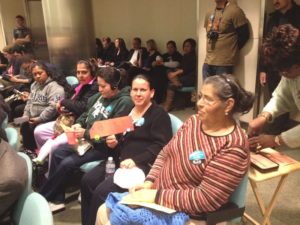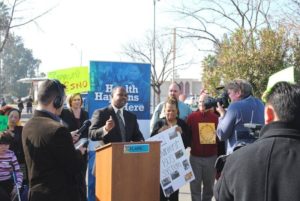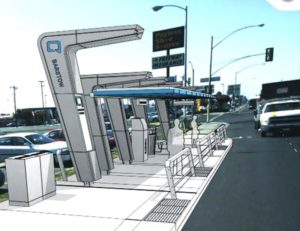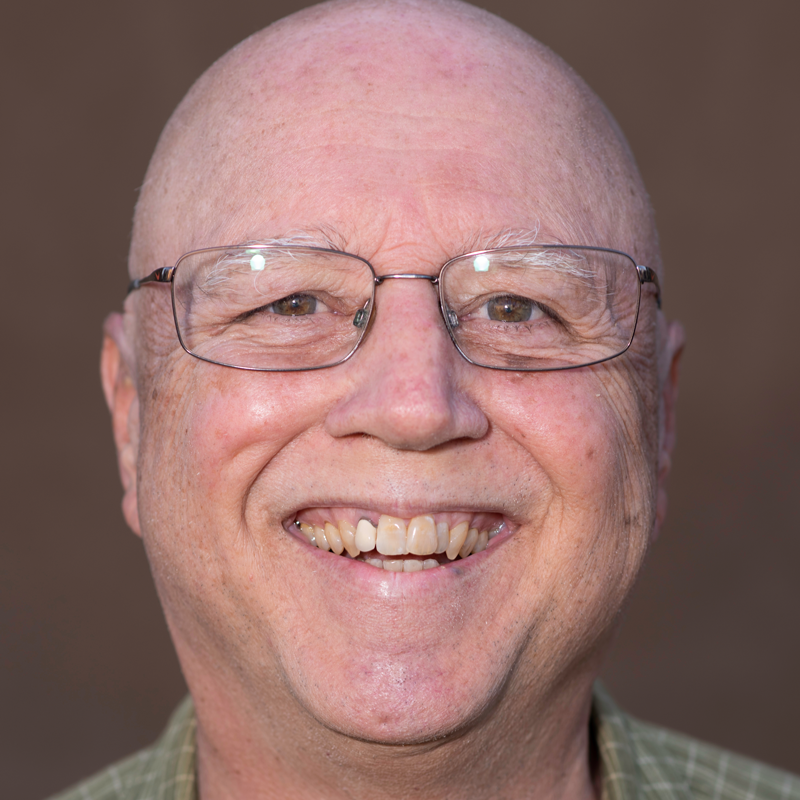
By Sarah Sharpe
What Happened?
On Jan. 30, after a long and contentious public hearing, in the wee hours of the morning just after midnight, the Fresno City Council voted to halt progress on the Bus Rapid Transit (BRT) project for the future of Fresno. The proposal, which would significantly improve the most-used bus routes in town along the Blackstone and Ventura/Kings Canyon corridors, has been in the works for more than seven years. The proposed project includes new, longer, more comfortable and accessible buses, raised bus stops for level boarding, prepay stations, and other changes and amenities designed to save time, increase travel speed and make transit more convenient for all riders.
After multiple green lights from previous City Councils and what seemed like community consensus on the direction of our city growth plans, it should have been a routine, easy decision. But the roughly 75 interested residents who stayed after midnight to witness the deliberations left disappointed and confused by the logic of the arguments of those opposed to the BRT project. In a 4-3 vote, the City Council put the BRT project on hold and simultaneously put into question whether Fresno will keep the $50 million in state and federal funding the city competed for and was chosen to receive for the project.
Hundreds of Fresnans attended the hearing, and some said public comment records were broken (at least for recent times), with more than 90 people commenting on the issue covering a wide range of opinions and concerns. Nearly everyone agreed that our current FAX system needs improvements like extended hours and routes, more frequent buses, and cleaner and safer buses and stops. A large contingent of the group was there to express support, but supporters included some unlikely suspects. The long General Plan Update process has begun to galvanize our city by uniting many folks who recognize the negative growing effects of Fresno’s past development decisions and its current spread-out suburban patterns.

Many of the people in favor of BRT support it after years of learning about and engaging in the city’s 2035 General Plan Update and the Downtown Neighborhoods planning process. There has been an intentional and much-needed effort to include the more diverse populations in our city in the planning processes through a collaborative called Fresno Leaders Advocating for Regional Equity (FLARE) Together. These are residents who primarily live in south Fresno, and many speak languages other than English such as Spanish, Hmong, Laotian and Mixteco.
They have been participating in a campaign called Building Healthy Communities (BHC), focused on investing and supporting existing already-built neighborhoods in the city, many of which have been long neglected, are experiencing visible urban decay, documented safety and health issues, and now hold large populations of families and children struggling with the effects of concentrated poverty surrounding them. There is ample evidence and a broadening recognition that these conditions are growing as the city spreads out further on its edges, threatening quality-of-life conditions and opportunities in even well-off neighborhoods in our city.

FLARE Together, BHC and many others are asking city leaders to support BRT and its full implementation as one of many key infrastructure investments required to help our existing neighborhoods and business districts revitalize and become positive contributors to Fresno’s image and economy. An improved transit system via BRT was supported by a broad swath of our community from Scott Miller speaking on behalf of the Chamber of Commerce to Stephan Walter, senior VP/CFO at Community Regional Medical Centers, as one of our largest single employers, to mothers like Elvia Quezada in southeast Fresno who depend on the bus as their primary transportation, to young creative professionals of Creative Fresno.
“The question before us is: Do we want to be a great city?” posed Randy White, D. Min., executive director of the Center for Community Transformation at Fresno Pacific University. “We need a sophisticated, multifaceted bus system; this is an investment. That’s what great cities do; they find the discipline and way to make the investment.”
Opponents of BRT have organized some new constituencies including some who focused explicitly on philosophical opposition to the concept of accepting federal funding for the project in Fresno. Some of the prevailing concerns were funding for the long-term operational sustainability of BRT, the loss of parking to a few businesses and disbelief in ridership projections.
Yet, in City Council statements at the close of the hearing, a few of the “no” votes explicitly stated that their issues are not about BRT but rather about the proposed General Plan Update. In a later conversation with the most publicly vocal opponent of BRT, City Council Member Clint Olivier, he professed that he was not acting with ulterior motives to undermine the General Plan Update or to toe the line for the Tea Party. Olivier is “hopeful that we can come to a compromise” in the near future.
However, City Council President Steve Brandau is openly aligned with the Tea Party activists who nationally have declared war on smart growth and sustainability planning, claiming it is an underhanded effort by the government to control private property and accomplish the goals set forth by UN Agenda 21.
Olivier says he believes the City Council will work out a compromise with Mayor Ashley Swearengin’s administration and that it will be a 6-1 “yes” vote next time, and he predicts Brandau will be the only holdout.
So What Was It Really About?

Joe Moore of Valley Public Radio published an opinion piece in the Fresno Bee on Feb. 7 highlighting the role of Mayor Swearengin in this debate: “Now that the dust has settled following the Fresno City Council vote against Bus Rapid Transit, the implications of the move have become increasingly clear and suggest the next 35 months of Mayor Ashley Swearengin’s term will be especially interesting.”
It’s true, the BRT project is a cornerstone piece to many of the mayor’s efforts, including the proposed General Plan Update, to improve the built environment and economic growth opportunities for all of Fresno by increasing infill and infrastructure investments in existing neighborhoods and business districts south of Herndon Avenue and to revitalize downtown.
It is well documented that certain parts of Fresno face severe obstacles to success because of so many people living in concentrated poverty neighborhoods with disproportionately poor health, crime, education and job market outcomes, and that these conditions are growing and spreading to other areas of town. The mayor’s focus on addressing concentrated poverty conditions is well supported by empirical studies.
“Fresno is at a critical crossroads with important decisions to make that will impact future quality-of-life and economic opportunities for all residents,” reflected Christine Barker, FLARE Together coordinator. “The Mayor and Councilman [Oliver] Baines have been right on point as champions for investing in existing neighborhoods through infrastructure and land-use decisions.”
According to a 2011 Brookings Institute study, concentrated poverty can limit educational opportunities, lead to increased crime and poor health outcomes, hinder wealth building, reduce private-sector investment and increase prices for goods and services, and raise costs for local government. All these attributes of concentrated poverty accurately describe existing and expanding conditions in Fresno today and the legacy of a development growth model that intentionally leaves behind neglected and disinvested neighborhoods with families and children who must increasingly fend for themselves against both debilitating circumstances in everyday life and the downside of local urban planning and policy battles.
As much as this is about hostility toward the mayor and her persistent efforts to improve all of Fresno, it is also about certain developers flexing their political power to continue the growth direction of our city ever outward by converting ever more farmland to housing subdivisions. A focus on infill development has proven to improve the economy and quality of life in many other major cities, yet it doesn’t currently generate as much profit in Fresno as the 70-year-old greenfield development model used on the city’s edge, and thus some interests with short-term perspectives continue to conclude that infill is not feasible in Fresno.
“Farmland conservation cannot be disassociated from infill development. They are inexorably linked. Poor public policy on land use has oversupplied the housing market for large-lot single family homes, which in turn not only devalues existing home values and divests from existing neighborhoods, it needlessly consumes prime farmland. The business-as-usual model is a lose-lose scenario,” commented Daniel O’Connell, American Farmland Trust’s program manager for the San Joaquin Valley.
The BRT project, which is designed to improve infrastructure and increase the value of property and businesses on the important corridors of Fresno, is a key strategy in future plans for the city to increase infill, reduce vehicle miles traveled by our residents and improve air quality. Not only does the city’s General Plan Update Alternative A rely on the project, but Fresno County’s Council of Governments also has a piece of its regional transportation plan called the Sustainable Community Strategy that included the city’s planning assumptions to reach its greenhouse gas reduction goals to comply with state law SB 375. If the City Council sticks with its decision to reject BRT, both planning bodies will be forced to start their planning processes again, which would generate millions of dollars in added planning expenses.
The BRT project is not dead; in fact, the City Council voted unanimously to approve the environmental certification and in closing comments many of the “no” votes stated that this issue would be coming back for more discussion.
Mayor Swearengin summed it up nicely in her response to the vote, “We had a healthy debate tonight about an important issue in our community: the future of public transit and the overall plan for growth in our community. While I am disappointed in tonight’s vote, I am committed to working with my colleagues on the City Council to address concerns they have and bring this item back for reconsideration.”
To learn more, contact Better Transit Fresno via Christine Barker at 559-487-1500 or Sarah Sharpe at sarah@fresnometmin.org, or search for FLARE Together/Juntos on Facebook.
*****
Sarah Sharpe is the director of programs for Fresno Metro Ministry. Contact her at 559-485-1416 or sarah@fresnometmin.org.

